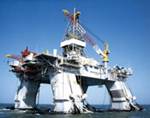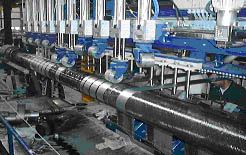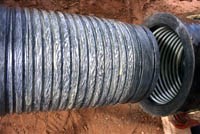New steel-strip-reinforced fiberglass pipe handles high-pressure oilfield applications
Hybrid technology positions composite pipeline to compete with steel in land and sea oilfields.
Ameron International (Pasadena, Calif.), manufactures composite piping for demanding oil industry applications. The company's standard 152-mm/6-inch filament wound glass-reinforced epoxy oilfield lines withstand oil temperatures in the 38°C to 82°C (100°F to 180°F) range and operating pressures as high as 100 bar/2,000 psi. Until recently, however, oil exploration companies typically have used lined and coated X60 steel pipe when larger diameters were required, because of concerns about the pressure-handling capabilities of fiberglass pipe. Seeing the potential for an economical large-diameter composite pipe, Ameron developed its patented hybrid Steel-strip Laminate (SSL) composite design that incorporates reinforcing plies of thin, 4-inch wide coiled stainless steel strips into the filament wound composite structure. SSL pipe can be produced in diameters from 203 mm to 1,016 mm/8 inches to 40 inches, with temperature ratings as high as 93°C/200°F, pressure ratings to 388 bar/5,600 psi and burst pressures from 827 bar to 1034 bar/12,000 psi to 15,000 psi.
"The core steel strip laminate is the primary load-bearing element," explains Dr. SuSu Wang of the Composites Engineering and Applications Center (CEAC), at the University of Houston (Houston, Texas). Based on its non-linear (ply-by-ply) elastoplastic progressive failure analysis of the SSL pipe structure, CEAC concluded that "the common concern of size effect on FRP [fiber-reinforced plastic] pipe pressure rating should not be an issue in the safe design of SSL pipe." SSL is expected to find use onshore in secondary recovery operations, which often entail injecting "produced water" into an oil-bearing substrate to increase oil production. Produced water is a hazardous byproduct of the oil drilling process for which re-injection into the rock strata is an acceptable method of disposal. Larger SSL pipe can handle higher injection pressures, increase flow volume and speed, and resist the effects of the highly corrosive water. In offshore exploration, heavy steel riser pipes pose the risk of sinking their platforms. At 914.4m /3,000 ft depth, an SSL or carbon composite riser has substantial economic benefits due to the weight advantage, compared to steel, says Rocky Friedrich, Ameron's VP for corporate research and engineering. Although the initial cost of SSL 10-inch diameter ($50/ft) is about 40 percent higher than that of X60 steel ($35/ft), Friedrich says cost analyses show that SSL slashes pipe weight and life-cycle cost by half, compared to X60 steel pipe onshore, and even more in subsea installations.
Complex calculations
Ameron's strategy was first to fully develop and implement SSL technology in corrosive applications onshore, then apply the technology for offshore application. Initial design analysis involved complex calculations of load sharing between Ameron's standard glass-reinforced epoxy pipe and the proposed steel wrapping. The design required that the axial and diametral strain performance values of both materials be the same under load since, in the SSL pipe, they would be intimately bonded together.
Stress calculations are based on standards established in ISO 14692 Petroleum and Natural Gas Industries - Glass-reinforced Plastics Piping (International Organization for Standardization, Geneva, Switzerland, December 2002), which recognizes that the allowable long-term applied stress to the glass-reinforced epoxy layers in the hoop direction actually depends on the ratio of hoop to axial stress (R-ratio). Earlier standards from the American Petroleum Institute (API, Washington, D.C.) and ASTM International (ASTM, W. Conshohocken, Pa.) load the pipe section as a closed-end pressure vessel, with a 2:1 ratio of hoop stress to axial stress.
Pipe analysis was done in Mathcad from Mathsoft Engineering & Education Inc. (Cambridge, Mass.) and Caesar II FEA pipeline analysis software, supplied by Coade Engineering Software Inc. (Houston, Texas) Design safety factors are based on API 15HR, High Pressure Fiberglass Line Pipe, which calls for a 1.5:1 safety factor to the 97.5 percent low confidence limit after 20 years of service (that is, by statistical probability, only 2.5 percent of the data points will be below the predicted range at the end of that period).
Loads were basically calculated as follows: The hoop modulus of the glass/epoxy liner is ~3.93 million psi/27.1 GPa at 65.5°C/150°F, while the hoop modulus of the steel reinforcement is ~30 million psi/207 GPa, a ratio of about 7.63:1 — a substantial difference. The long-term allowable stress in the glass/epoxy is around 79 MPa/11,500 psi at 65.5°C/150°F, based on long-term regression analysis per ASTM D2992, so the applied stress in the steel layers is 7.63 x 11,500 = 87,745 psi or 605 MPa.
"The actual load sharing is more complicated than these simplified calculations and must balance eight equations and eight unknowns, recognizing the hoop and axial modulus of both the steel and glass/epoxy layers, the Poisson's ratio in both directions, plus a force balance in both directions," says Friedrich. "But the result is very similar."
The next step was selection of the type of steel reinforcement to handle the calculated applied stress. ASME B31.4 (American Society of Mechanical Engineers, New York, N.Y.) requires that the steel layers, taken together as a bonded unit, must have a calculated stress less than or equal to 72 percent of the specified minimum yield strength (SMYS) of the steel used. A design stress of 87,745 psi requires an SMYS for the steel layers of 841 MPa/122,000 psi, calculated as 87,745/0.72 = ~121,868, or the equivalent of X122 steel pipe. In comparison, the SMYS of X60 steel pipe is 413 MPa/60,000 psi. Ameron selected Ducal 1400 steel from SSAB Svenskt Stal AB (Stockholm, Sweden), which offers a minimum tensile strength of 1,400 MPa/203,000 psi and an SMYS of 1,050 MPa/152,250 psi, which more than meets the 122,000 psi requirement.
A key design challenge was economical preparation of the coiled steel strips for bonding with the laminate. Ameron developed its own proprietary equipment to automatically clean the steel and coat it with Sol-Gel, a silicone-oxygen and reactive polymer solution (Si-O-R) also developed by Ameron. The coating is heat-cured onto both sides of the steel strips, forming a metal oxide bond to the steel surface that Friedrich calls "stronger than an adhesive bond." The steel is then re-coiled for the pipe winding operation. In the SSL pipe-curing process, the reactive polymer, an amine, chemically reacts with epoxy resin on the steel strips. The entire cleaning/coating operation is automated and runs unattended, at a cost of only about 0.5 cents/lb of steel.
The structural architecture
SSL pipe is produced in 40-ft/12.2m lengths at Ameron's plant in Geldermalsen, The Netherlands. Pipe winding is done on two automated machines in a concurrent procedure, using automated handling equipment for transfer of the 45-ft mandrels between stations.
The composite laminate consists of PPG or equivalent 450 yield E-glass roving (PPG Industries, Pittsburgh, Pa.) and EPON 827 cycloaliphatic amine cured epoxy (IPDA), or, for temperature ratings as high as 121.1°C/250°F, EPON 828 aromatic amine-cured epoxy (MDA) resin, produced by Resolution Performance Products (Houston, Texas, now part of Hexion Specialty Chenicals; see "Related Suppliers," at left). Both resin systems are unfilled and, other than the addition of carbon black for enhanced UV resistance, are used as supplied by the manufacturer. Fiber content of the final product is 75 percent by weight. The ratio of fiberglass-to-steel can be custom-designed for specific job requirements, by building up the wall thickness with fiberglass to add external collapse resistance or adding more steel to increase pressure capability.
The ply schedule begins with a glass-reinforced epoxy inner liner wound with resin-wet fiberglass at ±54°, the traditional helical angle for pressure vessels. No C-veil or other additional liner is necessary for corrosion resistance. Minimum liner thickness is 3 mm/0.118 inch. The liner is wound over a precision-machined steel mandrel on proprietary filament winding equipment. Next, the liner/mandrel is moved to a steel-strip winder, where steel layers 101.6 mm/4 inches wide and 0.5 mm/0.0197 inches thick are wound over the liner at an 81° angle or greater, depending on diameter, with a gap of 1 mm to 5 mm/0.04 inches to 0.20 inches between the edges of the steel strips. Three to 10 layers (SSL3 to SSL10) are simultaneously wrapped around the fiberglass laminate in one pass, one steel strip per layer, using automated, multihead equipment.
The first, bottom strip/layer is applied directly to the fiberglass liner. Subsequent strips are separated by Reemay spunbonded polyester veil supplied by Precision Fabrics Group Inc./Formed Fabrics Div. (Greensboro, N.C.), which has been drawn automatically through the epoxy resin bath. The veil delivers the epoxy that ultimately bonds the steel strips together as a unified, isotropic core, capable of handling loads in any direction. The veil is integrated between the layers from below the mandrel, while the steel strips are applied from the top of the mandrel. Each steel strip is individually tensioned in the winding head by a computer-controlled, floating "dancer roll" positioned by an air cylinder. The air pressure in the cylinder sets the tension. The strip is coiled by pulling it through forming rolls as it is pulled onto the mandrel. The steel layers start and stop 12 mm to 50 mm/0.5 inches to 2 inches from the ends of the pipe. To avoid a stress riser at the pipe ends, the strips are terminated in a stairstep pattern (see drawing, at right.
Afterward, the mandrel is returned to the filament winder for its fiberglass outer jacket, wound at a ±54° angle (minimum jacket thickness of 1.52 mm/0.060 inch) directly over the top layer of steel. Finally, pipe ends are modified for Ameron's patented Coil-Lock pipe joint. On one end, an integral spigot is built up, using a combination of ±54° and ±70° to ±80° winding angles. On the other, the joint's bell is wound on at angles between ±70° to ±80° with the additional reinforcement of unidirectional fiberglass tape from Saint-Gobain BTI (Brunswick, Maine). The tape and roving are wound simultaneously from separate NC-controlled carriages, positioned on opposite sides of the mandrel.
The pipe laminate is cured in an Ameron-built 48-ft/14.6m computer-controlled oven for two hours or more until the outer surface reaches a minimum temperature of 150°C/302°F. (Pipe 406 mm/16 inches in diameter or less can be cured two at a time; cure time lengthens with increased diameter/thickness.) After cure, the pipe is demolded. Bolted to the spigot end of the mandrel and overwound with the rovings during fabrication, a "pump off bell" with the same outside diameter as the mandrel is unbolted and water, injected under high pressure between the bell and the mandrel, hydraulically strips the pipe from the mandrel.
The pipe ends are then square cut to exact length and grooves for the threaded joint are machined on a numerically controlled lathe. Nylon or aluminum key threads are inserted into the grooves in the bell end during installation (see photo, at right).
Test lines in Argentina, Venezuela and Saudi Arabia are receiving top grades, Friedrich says. Saudi Aramco (Dhahran, Saudi Arabia) is preparing to install its second test line - SSL10, 10-inch,254-mm diameter pipe designed for 200 bars/3,000 psi secondary recovery water injection at 93.3°C/200°F.
The next step is to turn SSL into a commercially viable offshore production riser. Analytical models are underway with prototype testing and statistical analyses of repeatability to be performed in the near future. Continuous SSL winding equipment, needed to minimize the number of joints, is next on the agenda. And Ameron is looking for NIST ATP funding or a joint industry program to help make this emerging technology a commercial reality. "The oil companies can't get to 1,828.8m to 3,048m/6,000 ft to 10,000 ft transporting corrosive fluids without a composite riser," Friedrich concludes.
Related Content
Plant tour: ÉireComposites, Galway, Ireland
An in-house testing business and R&D focus has led to innovative materials use and projects in a range of markets, from civil aerospace to renewable energy to marine.
Read MoreDrawing design cues from nature: Designing for biomimetic composites, Part 1
Biomimicry is an interdisciplinary methodology that can inform composites design and manufacturing via use of more effective and sustainable materials, structural fabrication and technological practices.
Read MorePEEK vs. PEKK vs. PAEK and continuous compression molding
Suppliers of thermoplastics and carbon fiber chime in regarding PEEK vs. PEKK, and now PAEK, as well as in-situ consolidation — the supply chain for thermoplastic tape composites continues to evolve.
Read MoreThe next evolution in AFP
Automated fiber placement develops into more compact, flexible, modular and digitized systems with multi-material and process capabilities.
Read MoreRead Next
Offshore Applications: The Future Is Now
The number of composites installations continues to grow on new and existing offshore facilities.
Read MoreComposites end markets: Energy (2024)
Composites are used widely in oil/gas, wind and other renewable energy applications. Despite market challenges, growth potential and innovation for composites continue.
Read MoreCW’s 2024 Top Shops survey offers new approach to benchmarking
Respondents that complete the survey by April 30, 2024, have the chance to be recognized as an honoree.
Read More
















.jpg;maxWidth=300;quality=90)














